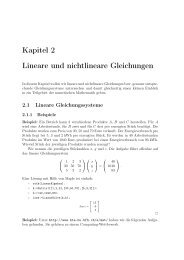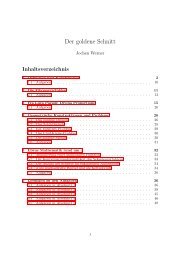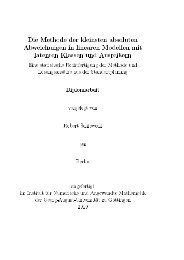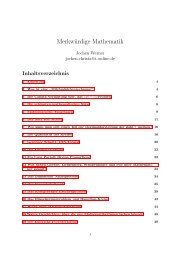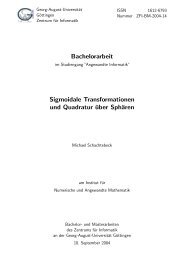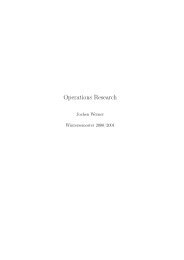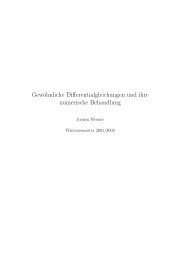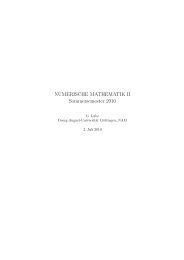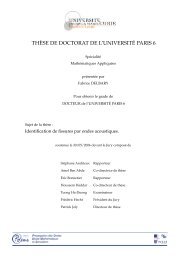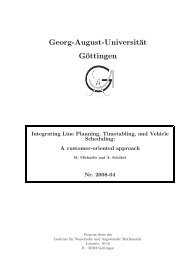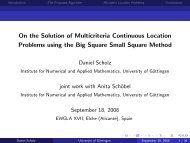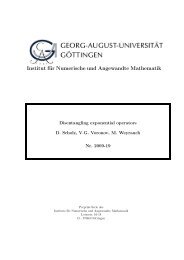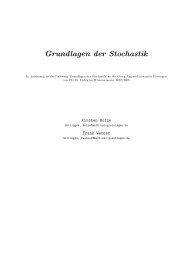BAIL 2006 Book of Abstracts - Institut für Numerische und ...
BAIL 2006 Book of Abstracts - Institut für Numerische und ...
BAIL 2006 Book of Abstracts - Institut für Numerische und ...
You also want an ePaper? Increase the reach of your titles
YUMPU automatically turns print PDFs into web optimized ePapers that Google loves.
S. LI, L.P. SHISHKINA, G.I. SHISHKIN: Parameter-Uniform Method for a Singularly<br />
Perturbed Parabolic Equation Modelling the Black-Scholes equation in the Presence<br />
<strong>of</strong> Interior and Bo<strong>und</strong>ary Layers<br />
✬<br />
✫<br />
Parameter–Uniform Method for a Singularly Perturbed Parabolic Equation<br />
Modelling the Black–Scholes equation in the Presence <strong>of</strong> Interior and<br />
Bo<strong>und</strong>ary Layers ∗<br />
Shuiying Li 1 , Lidia P. Shishkina 2 and Grigory I. Shishkin 2<br />
1 Department <strong>of</strong> Computational Science,<br />
National University <strong>of</strong> Singapore,<br />
Singapore 117543<br />
scip1075@nus.edu.sg<br />
2 <strong>Institut</strong>e <strong>of</strong> Mathematics and Mechanics,<br />
Ural Branch <strong>of</strong> Russian Academy <strong>of</strong> Sciences,<br />
Yekaterinburg 620219, Russia<br />
Lida@convex.ru and shishkin@imm.uran.ru<br />
Solutions <strong>of</strong> regular parabolic equations with nonsmooth initial data are <strong>of</strong> limited smoothness<br />
themselves (in a neighbourhood <strong>of</strong> the nonsmoothness <strong>of</strong> the data). When the equation<br />
is singularly perturbed, its solution has singularities such as initial, bo<strong>und</strong>ary and/or interior<br />
layers with own scales. These problems belong to the class <strong>of</strong> singularly perturbed multiscale<br />
problems. The multiscale behaviour <strong>of</strong> solutions complicates the construction and study <strong>of</strong><br />
efficient patameter-uniform numerical methods.<br />
A singularly perturbed parabolic convection-diffusion equation with the second derivative<br />
multiplied by a singular perturbation parameter ε, which ranges in (0, 1], arises when we model<br />
the Black-Scholes equation upon a European call option (see, e.g., [1]). There are a few singularities<br />
in the problem, i.e., a single discontinuity <strong>of</strong> the first derivative <strong>of</strong> the initial condition<br />
at a point x0, the unbo<strong>und</strong>ed growth <strong>of</strong> the initial condition at infinity and the unbo<strong>und</strong>ed<br />
domain in space. The solution <strong>of</strong> this initial value problem grows exponentially without bo<strong>und</strong><br />
as x → ∞. Thus, we deal with a singularly perturbed multiscale problem that has different<br />
types <strong>of</strong> singularities.<br />
In this presentation we consider a bo<strong>und</strong>ary value problem (in a bo<strong>und</strong>ed domain) for this<br />
singularly perturbed parabolic convection-diffusion equation with an additional singularity generated<br />
by the discontinuity <strong>of</strong> the first derivative <strong>of</strong> the initial function. For such a problem,<br />
singularities such as a bo<strong>und</strong>ary and an interior layer with own specific scales arise. For small<br />
values <strong>of</strong> the parameter ε, the interior layer due to nonsmooth initial data appears in a neighbourhood<br />
<strong>of</strong> the characteristic <strong>of</strong> the reduced equation passing through the point (x0, 0), and<br />
the regular bo<strong>und</strong>ary layer appears in a neighbourhood <strong>of</strong> the outflow bo<strong>und</strong>ary through which<br />
the convective flux leaves the domain.<br />
By using the singularity splitting method and piecewise uniform meshes condensing in the<br />
bo<strong>und</strong>ary layer, we construct a special difference scheme that allows us to approximate εuniformly<br />
the solution <strong>of</strong> the problem <strong>und</strong>er consideration, as well as the first derivative <strong>of</strong><br />
the solution. The corresponding theoretical and numerical results are provided in the paper.<br />
The description <strong>of</strong> the technique applied in this study can be fo<strong>und</strong> in [2]. Preliminary results<br />
for a similar problem with no bo<strong>und</strong>ary layer were given in [3].<br />
∗ This research was supported in part by the Russian Fo<strong>und</strong>ation for Basic Research (grant No 04-01-00578,<br />
04–01–89007–NWO a) and by the Dutch Research Organization NWO <strong>und</strong>er grant No 047.016.008.<br />
1<br />
Speaker: SHISHKINA, L.P. 59 <strong>BAIL</strong> <strong>2006</strong><br />
✩<br />
✪



